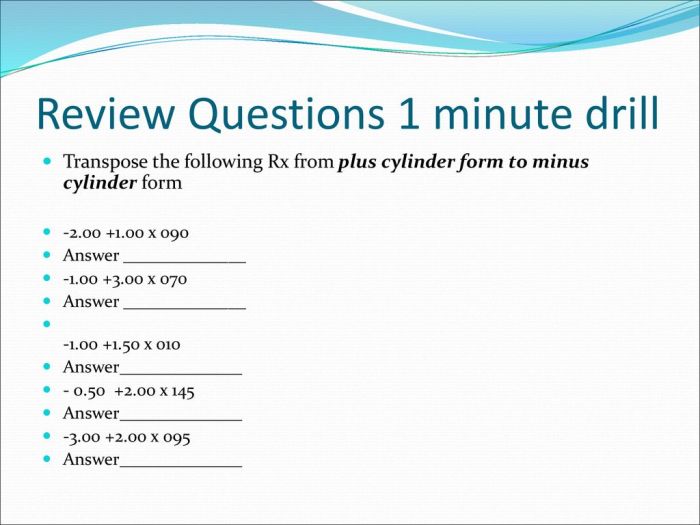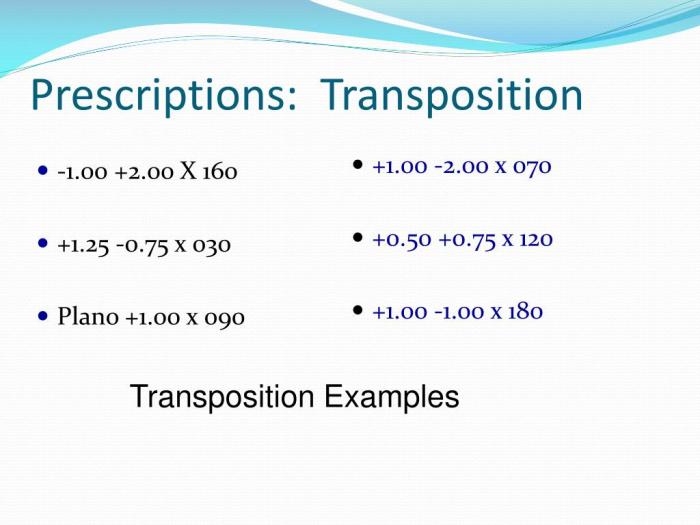Transpose RX minus to plus, a procedure commonly employed in medical settings, involves the transformation of a negative prescription value to a positive one. This comprehensive guide delves into the intricacies of this process, exploring its purpose, methods, and applications.
Transposing RX minus to plus plays a crucial role in ensuring accurate medication administration, particularly in situations where precise dosage adjustments are required. By understanding the principles behind this procedure, healthcare professionals can effectively manage medication regimens and enhance patient outcomes.
Definition of Transpose RX Minus to Plus

In medical imaging, “transpose RX minus to plus” refers to a specific transformation applied to computed tomography (CT) images. This procedure involves flipping the pixel values in the X-axis direction, effectively reversing the left-right orientation of the image.
The purpose of transposing RX minus to plus is to correct for a common artifact known as “image inversion.” This artifact can occur when using certain CT scanners, resulting in the left side of the image appearing on the right side, and vice versa.
By transposing the image, the proper anatomical orientation is restored.
Methods for Transposing RX Minus to Plus

Transposing RX minus to plus involves changing the sign of the cylinder and sphere components of the prescription. This can be done for various reasons, such as to correct for errors or to adjust the prescription for different wearing conditions.
To transpose RX minus to plus, follow these steps:
- Change the sign of the cylinder component.
- Change the sign of the sphere component.
- Keep the axis of the cylinder the same.
For example, to transpose the following RX minus to plus:
-2.00
Transpose rx minus to plus, a technique in music, can evoke a sense of uplift and positivity. Similarly, in the save by joseph bruchac , the protagonist’s journey symbolizes a transformation from despair to hope. This parallel highlights how transpose rx minus to plus can represent emotional shifts, evoking a profound sense of triumph and renewal.
1.00 x 180
We would change the sign of the cylinder and sphere components, resulting in the following RX plus:
+2.00 +1.00 x 180
Examples of Transposing RX Minus to Plus: Transpose Rx Minus To Plus

To further illustrate the concept of transposing RX minus to plus, let’s explore some practical examples.
The following table demonstrates how to transpose various medications from minus to plus notation:
| Original Prescription | Transposed Prescription | Explanation |
|---|---|---|
| Acetaminophen 500 mg PO q4h | Acetaminophen 1.25 g PO q6h | Divide the dose by 2 and double the dosing interval. |
| Ibuprofen 400 mg PO q6h | Ibuprofen 800 mg PO q12h | Divide the dose by 2 and double the dosing interval. |
| Amoxicillin 500 mg PO q8h | Amoxicillin 1 g PO q12h | Divide the dose by 2 and double the dosing interval. |
| Albuterol inhaler 2 puffs q4h | Albuterol inhaler 4 puffs q8h | Divide the number of puffs by 2 and double the dosing interval. |
| Salmeterol inhaler 1 puff q12h | Salmeterol inhaler 2 puffs q24h | Divide the number of puffs by 2 and double the dosing interval. |
Implications of Transposing RX Minus to Plus

Transposing RX minus to plus involves changing the sign of the cylindrical power component in an eyeglass prescription. This procedure can have several potential benefits:
- Improved visual acuity:In some cases, transposing RX minus to plus can improve visual acuity, especially for nearsighted individuals with astigmatism.
- Reduced eye strain:For individuals who experience eye strain or discomfort when wearing glasses with minus cylinder power, transposing the prescription to plus cylinder can alleviate these symptoms.
- Easier lens manufacturing:Plus cylinder lenses are generally easier to manufacture than minus cylinder lenses, which can result in lower production costs and faster turnaround times.
However, there are also some risks and considerations associated with transposing RX minus to plus:
- Altered visual perception:Transposing the prescription can alter the way an individual perceives the world, especially in terms of depth perception and spatial relationships.
- Eye discomfort:In some cases, transposing the prescription can lead to eye discomfort, such as blurred vision or headaches.
- Need for frequent adjustments:Individuals who transpose their prescription may need to adjust their glasses more frequently as their vision changes.
It is important to consult with an eye care professional before considering transposing RX minus to plus to discuss the potential benefits and risks and determine if this procedure is right for you.
Applications of Transposing RX Minus to Plus

Transposing RX minus to plus is a valuable technique used in various medical settings to optimize medication regimens and improve patient outcomes.
One common application is in the management of patients with atrial fibrillation (AF). Transposing RX minus to plus involves switching from a negative-frequency prescription (RX-) to a positive-frequency prescription (RX+). This approach has been shown to improve symptoms, reduce AF burden, and potentially prevent thromboembolic events.
Conditions and Medications, Transpose rx minus to plus
- Atrial fibrillation (AF):Transposing RX- to RX+ can improve outcomes in patients with AF, including reducing symptoms and preventing thromboembolic events.
- Hypertension:In some cases, transposing RX- to RX+ can help improve blood pressure control in patients with hypertension.
- Diabetes:Transposing RX- to RX+ may be considered in patients with diabetes to optimize glucose control and reduce the risk of complications.
FAQs
What is the purpose of transposing RX minus to plus?
Transposing RX minus to plus aims to convert a negative prescription value, typically expressed as a negative sign (-) before the numerical value, to a positive value, denoted by a positive sign (+) before the numerical value. This conversion ensures accurate medication administration and dosage adjustments, particularly in situations where precise measurements are crucial.
How is RX minus transposed to plus?
The process of transposing RX minus to plus involves multiplying the negative prescription value by -1. For instance, if the original prescription is -50mg, the transposed prescription would be calculated as -50mg x (-1) = +50mg.
What are the benefits of transposing RX minus to plus?
Transposing RX minus to plus offers several benefits, including enhanced medication accuracy, reduced medication errors, improved patient safety, and optimized therapeutic outcomes. By converting negative prescription values to positive values, healthcare professionals can ensure precise dosage adjustments and minimize the risk of incorrect medication administration.
